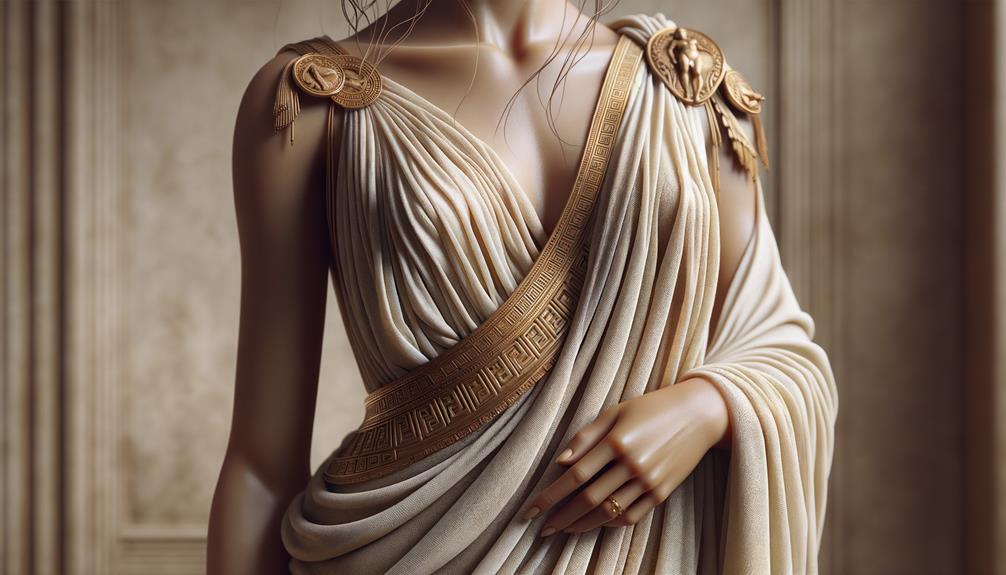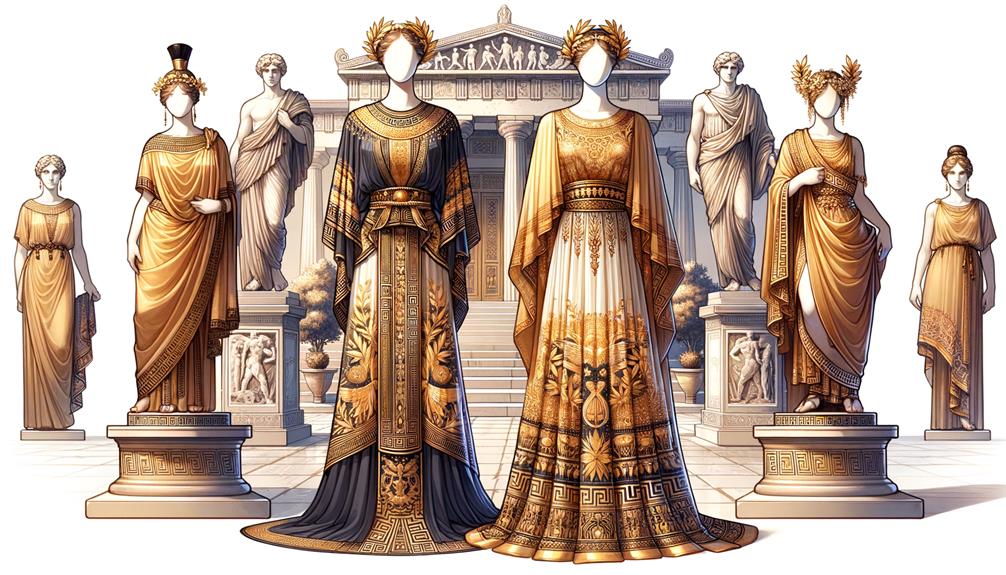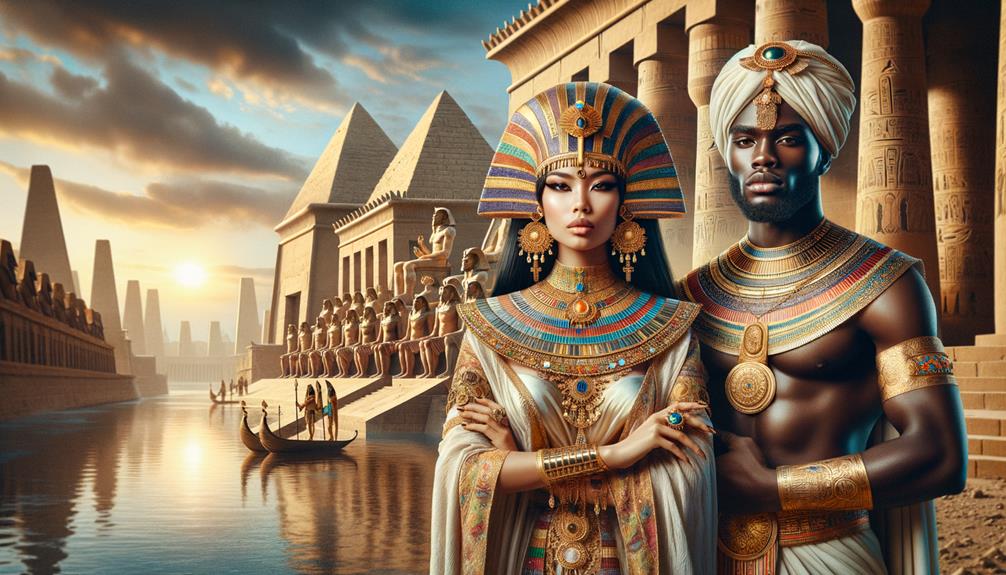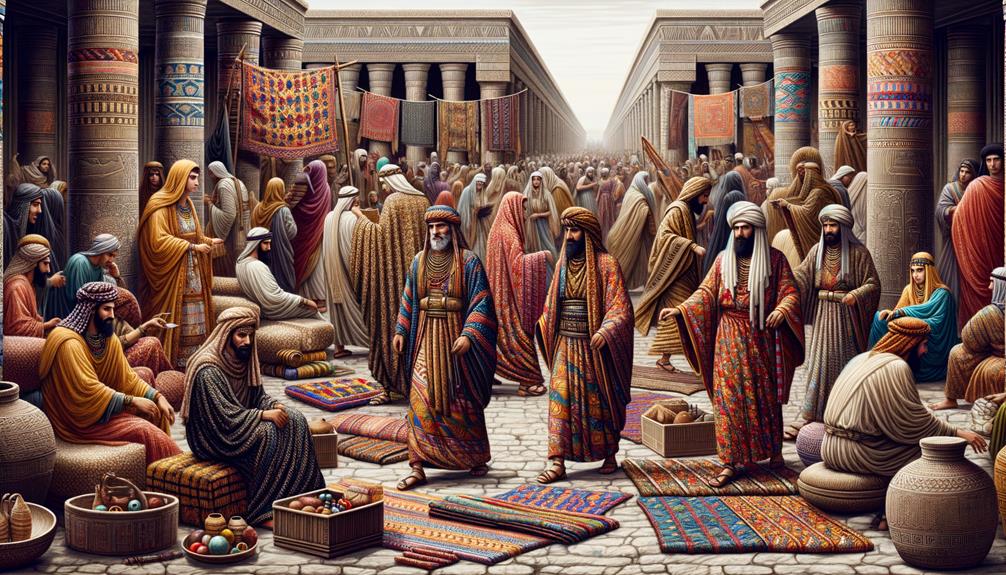I’ve always been fascinated by the elegance and practicality of ancient Greek fashion, particularly their use of drapery. They crafted beautiful garments from single pieces of cloth, like the peplos and chiton, which were folded and pinned to accentuate the body’s natural curves. The himation, worn over other clothing, added a touch of sophistication and versatility. Clothing wasn’t just functional; it conveyed social status, modesty, and even divinity through intricate folds and fabrics. A closer look at their artistry reveals a great deal about the cultural values and innovations of the time. There’s still much to uncover about their extraordinary sartorial choices.
Origins of Greek Drapery
The origins of Greek drapery in fashion date back to the artistic innovations seen in classical and Hellenistic Greek art. I’ve always been fascinated by how ancient Greek artists skillfully manipulated fabric to convey a sense of movement and elegance. They didn’t just depict clothing; they captured the essence of the human form beneath it. In ancient Greece, both men and women wore garments made from a single piece of cloth, carefully draped to prioritize both comfort and aesthetics.
Observing ancient Greek dress, it’s striking how the fabric flows naturally, accentuating the body’s contours and the wearer’s posture. This wasn’t a casual choice; it was a deliberate artistic decision. The wet-drapery technique, where fabric appears to cling to the body, highlights the intersection of art and fashion. It’s as if the fabric itself tells a story, hinting at both physical and ethereal qualities.
In modern fashion design, these principles remain influential. Designers today draw inspiration from how ancient Greeks expertly draped fabric, creating garments that exude timeless elegance. The precision and thoughtfulness of ancient Greek art continue to shape how we perceive and innovate with fabric, making it a perpetual source of inspiration.
The Peplos

Among the many garments of ancient Greece, I find the Peplos particularly fascinating due to its simplicity and cultural significance. This classic Greek garment, worn by women, is captivating in its straightforward design and profound affirmation. Made from a single piece of wool, the Peplos was a large, rectangular piece of cloth that was artfully draped around the body.
Women in ancient Greece would carefully pin and fold this fabric, ensuring it reached down to their ankles, creating an elegant silhouette. The Peplos wasn’t just about aesthetics; it held deep cultural importance. Often worn during religious ceremonies and festivals, this garment symbolized modesty and femininity, reflecting the values and traditions of the time.
What I find intriguing is how the Peplos evolved over time, becoming more intricate and decorative. This evolution mirrors the societal changes and shifts in fashion preferences, illustrating how a single piece of fabric could adapt to new trends while maintaining its essential essence. The Peplos stands out as a testament to the ingenuity and cultural richness of ancient Greek women’s attire, reminding us that even the simplest designs can carry significant meaning.
The Chiton

While the Peplos showcased simplicity and cultural depth, the Chiton captured my attention with its intricate design and evolving style. This ancient Greek garment, worn by both men and women, initially consisted of a two-piece construction that developed into a fashion statement of Classical Greece. Men favored longer Chitons, but over time, they shifted to shorter styles, reflecting practicality and changing aesthetics.
What fascinated me most was how the fabric was sewn and draped diagonally over one shoulder, creating a fluid silhouette that seemed to come alive in Greek Art. The Chiton wasn’t just functional; by the 4th century BCE, it became a canvas for vibrant colors and intricate designs. This elaborate decoration hinted at the garment’s Eastern origins and luxurious appeal, as suggested by the Semitic root of the word.
The Chiton’s versatility and adaptability allowed it to remain a staple throughout various Greek periods. Its ability to evolve into different lengths and styles speaks to an innovative spirit that resonates even today. Observing how it was worn, I appreciate the sophisticated craftsmanship and cultural significance this garment holds in the tapestry of ancient Greek fashion.
The Himation

The Himation, a staple of ancient Greek attire, fascinated me with its elegant simplicity and versatility. This draped garment, a rectangular piece of fabric, was a marvel of ancient Greek ingenuity. Typically worn as a cloak over the chiton, it added a layer of sophistication and practicality to the ensemble.
I was intrigued by how the Himation could be draped over one or both shoulders. Both men and women wore it, each adopting unique styles that reflected personal and societal norms. Made mainly from wool, the fabric’s texture and weight provided both warmth and modesty, essential in various social settings.
The Himation’s adaptability was striking. As a cloak, it could serve multiple purposes, from shielding the wearer from the elements to acting as an impromptu blanket or even a status symbol. The precision with which it was draped allowed for a range of expressions – from informal to dignified – depending on how one chose to wear it.
In essence, the Himation was more than just a garment; it made a statement. Its presence in ancient Greek fashion offers a glimpse into the ingenuity of clothing design, where form and function harmoniously coexisted.
Symbolism in Clothing

Clothing in ancient Greek art was more than just aesthetically pleasing – it was a powerful symbol of social status, gender roles, and cultural values. When I examine the intricacies of drapery, I realize that fabric folding and movement convey much more than mere style. The way garments flowed and moved depicted natural grace and elegance, essential in highlighting the wearer’s power and sophistication.
In ancient Greece, clothing played a significant role in defining societal norms. For example, the elaborate drapery often seen on statues of gods and goddesses wasn’t just for show – it was a clear marker of their elevated status. Similarly, warriors and statesmen were depicted with specific drapery styles to denote their importance and influence.
It’s fascinating to note that:
- Elaborate drapery signified divinity and heroism.
- Simpler clothing indicated humility or servitude.
- Specific styles defined gender roles and societal norms.
The ancient Greeks used fabric draping not just to adorn but to communicate profound cultural values. This interplay of clothing and symbolism offers us a glimpse into their world, revealing how deeply intertwined their fashion was with their identity and societal structures.
Frequently Asked Questions
What Were the Ancient Greek Drapes?
Ancient Greek drapes, like the chiton and himation, were crafted with flowing fabric and intricate folds. These garments symbolized more than just clothing; they embodied the culture’s deep appreciation for beauty and artistic expression.
What Is the Drapery in Ancient Greek Sculpture?
Isn’t it fascinating how ancient Greek sculptors managed to capture the fluidity of fabric in stone? The intricate folds and lifelike flow of the drapery reveal their exceptional skill and innovative approach.
What Is the History of Draping in Greece?
Here’s a rewritten version of the text:
I find the history of draping in Greece fascinating. It evolved from simple, functional garments to symbols of sophistication and elegance. The Greeks’ innovative fabric manipulation allowed for versatile styles, leaving a lasting impact on fashion.
What Kind of Fabric Did They Wear in Ancient Greece?
In ancient Greece, people wore fabrics made from linen and wool, often dyed in vibrant colors and adorned with intricate designs. Both men and women favored these materials for their everyday clothing, including tunics and cloaks.




